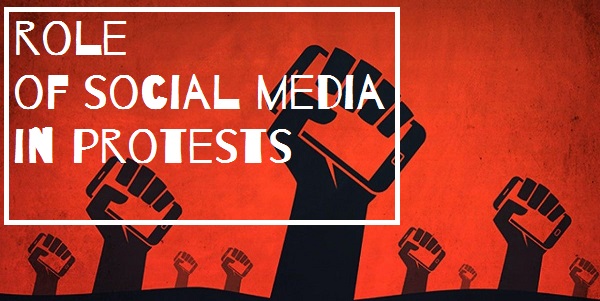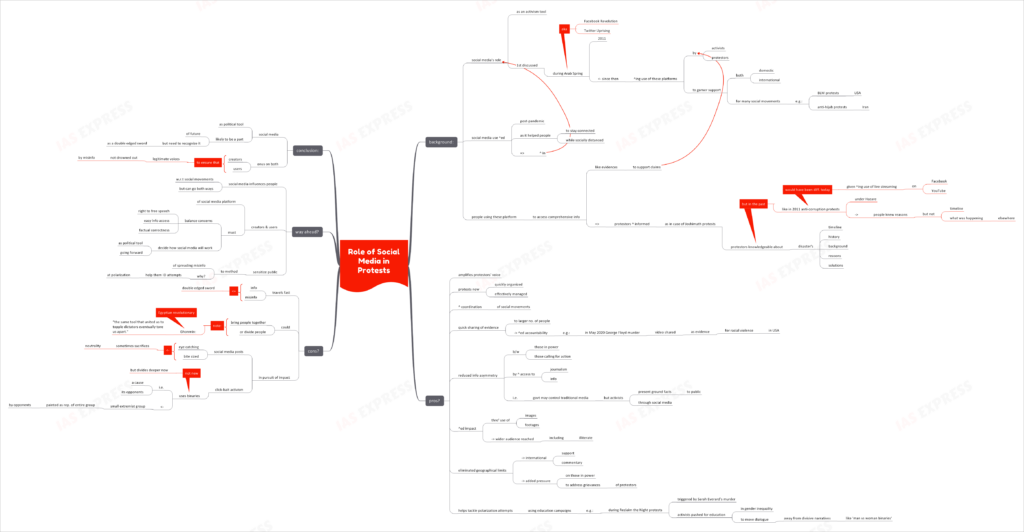Role of Social Media in Protests- Background, Pros & Cons

From Current Affairs Notes for UPSC » Editorials & In-depths » This topic
IAS EXPRESS Vs UPSC Prelims 2024: 85+ questions reflected
During the recent protests against the situation in Joshimath, reporters took note of how well informed the protestors on the ground were. This can be attributed to the growing role of social media in shaping modern day protests.

Background:
- Social media’s role as a tool for activism was first widely discussed during the Arab Spring in 2011. The movement even came to be known as the ‘Facebook Revolution’ and the ‘Twitter Uprising’.
- Since then, activists and protestors across the world have been increasingly using social media to garner domestic and global support for a range of social movements. Examples include the Black Lives Matter protests and the more recent anti-Hijab protests in Iran.
- The use of social media spiked especially after the pandemic struck. It served as a way for people to stay connected in a socially distanced society. This has further boosted these platform’s role in protest movements.
- People are increasingly depending on social media to access comprehensive information such as evidences to support protestors’ claims.
- As a result, protestors are becoming increasingly well informed. For instance, this was observed during the Joshimath protests- protestors were able to trace the disaster’s timeline, history, background (including details about the 1976 M C Mishra Committee report), give reasons and even suggest solutions.
- In the past, when social media was yet to put in deep roots, protestors were aware of the reasons for the movement, but not of other details like the timeline and what was happening in other parts of the country. This was the case in the 2011 anti-corruption protests under Anna Hazare. Today, the same protest would have been very different given the widespread use of live streaming on Facebook and YouTube.
What are the pros?
- Social media platforms have helped amplify the protestors’ voices and made social movements more coordinated.
- It has enabled activists to organize protests very quickly and manage them more efficiently. It has enabled evidences of injustice to be shared quickly to a large part of the public, given the widespread use of social media. This has been facilitating accountability. Eg: the May 2020 murder of George Floyd was filmed and shared as evidence for racial violence in the USA.
- These platforms have helped, by providing easier access to journalism and information sources, reduce the information asymmetry between the 2 sides in a protest- those in power and those fighting for a change. Activists are now able to inform the public about ground-facts even when authoritarian governments attempt to control the traditional media outlets.
- It enables sharing of material in the form of images and footages, created greater impact. This has enabled protestors access a wider part of the public, such as the illiterate.
- It has eliminated geographical limitation as protestors can now share their cause with international audience and elicit commentary and support. This has resulted in some protests garnering international support and added pressure on those in power to address the protestors’ grievances.
- It has helped activists counter attempts to trigger polarization through education campaigns. For instance, during the Reclaim the Nights protests triggered by Sarah Everard’s murder, activists took the opportunity to push for public education in gender inequality and to move the dialogue away from divisive narratives like ‘man vs woman binary’ that were triggering counter-protests.
What are the cons?
- While social media helps information travel at unprecedented rates, it does the same for misinformation, making these platforms a double-edged sword for social movements.
- This means that while it has the ability to bring people together for a common cause, it could also polarize the public. Notably, the Egyptian revolutionary Ghonmin said “the same tool that united us to topple dictators eventually tore us apart.”
- In pursuit of impactfulness, social media posts tend to be eye catching and bite-sized. This could come at the cost of neutrality.
- Such ‘click-bait’ activism tend to use binaries i.e. a cause and an opponent. This could mean that a small minority of extremists gets painted as representative of the whole group in its opposition’s perspective. While this isn’t unique to modern protests, social media has enabled the deepening of the divides.
What is the way ahead?
- The ability of social media to influence people with regards to social movements is undeniable. However, this influence can go in both directions.
- Hence, the creators and users of social media platforms must balance equally important concerns- right to free speech, easy access to information and factual correctness- to decide how social media will function as a political tool going forward.
- Sensitizing the public to the common methods by which misinformation is spread will help them identify malicious attempts to rip the social fabric.
Conclusion:
Social media as a political tool that takes the message to people across the world is likely to be a definite part of the future. However, it must be recognized for the double-edged sword that it is. The onus is on both- the creators and users- to make sure that legitimate voices aren’t drowned out by misinformation.
Practice Question for Mains:
Discuss the role of social media in modern-day protests. What are the pros and cons? (250 words)
If you like this post, please share your feedback in the comments section below so that we will upload more posts like this.

